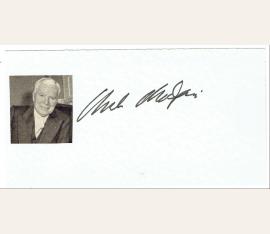iconic silent film actor and comedian (1889-1977). Signed and inscribed photograph. no place, no date. 250 : 200 mm. One crease running touching his head diagonally.
2.500 €
(91235)
A nice head and shoulders photograph of Chaplin signed and inscribed against the light background „To Leighton | my best wishes | Charlie Chaplin“.
iconic silent film actor and comedian (1889-1977). Signed album page. no place, no date. 77 : 146 mm. 1 page.
600 €
(92035)
Nice signature with an image of Chaplin affixed to it. Rare. Remnants from previous mounting to the verso.
iconic silent film actor and comedian (1889-1977). Signed album page. no place. 103 : 146 mm. Minor age toning.
1.250 €
(92036)
Nice ink signature on a 4 x 6 inch card with an image taken from a newspaper as The Tramp.
verkauft
Ms. Brief mit eigenh. Unterschrift.
Autograph ist nicht mehr verfügbar
An Mitglieder des Film Clubs in Siebeneichen: „Thank you very much for your kind thoughts on my eightieth birthday.“
Autograph letter signed “Charles Chaplin”.
Autograph ist nicht mehr verfügbar
To Mr. Williams, the innovative cinematographer FRANK D. WILLIAMS (1893-1961). “This will introduce Mr. Godowsky the son of the famous pianist. He has a wonderful invention which I know will interest you. It is a big improvement in the film industry. Hoping you will give Mr. Godowsky the assistance possible in the matter...” Although he began his film career in silent movies, Chaplin’s comic timing and talent for physical comedy carried him into the age of talkies, making him one of the biggest Hollywood stars of all time. His career is almost synonymous with his tramp character, but Chaplin continued to work in Hollywood long after the tramp’s last appearance in Modern Times. In 1919, he co-founded the United Artists film studio with Douglas Fairbanks, Mary Pickford and D.W. Griffith. Despite his longstanding American residency and prominence, Chaplin, during the McCarthy era, was suspected of being a Communist. His response to the accusations was to move to Europe and renounce his adopted American home. After a disappointing experience when viewing the 1917 film Our Navy in Prizma Color, a successor of Kinemacolor, American violinist and chemist Leopold Godowsky Jr. (1900-1983; son of the famous pianist, Leopold Godowsky, Sr., and future brother-in-law of George and Ira Gershwin) and his friend, pianist Leopold Mannes, designed a movie camera and projector that used colored filters, patenting a new color film process even before graduating high school. They continued their experimentation and research while Mannes studied physics and piano at Harvard and Godowsky violin at UCLA. Eventually, with backing from an investor, the pair convinced Kodak of the value of their discoveries. In 1930, they moved to Kodak’s Rochester headquarters and within three years had developed the technique of three-color emulsion that made Kodachrome film possible. Commercial sale of Kodachrome began in 1935 and continued until 2010. After perfecting Kodachrome, both Mannes and Godowsky returned to the world of music. An employee at Keystone Studios, Williams was Chaplin’s cinematographer for his earliest films including Kid Auto Races at Venice, A Film Johnnie, Caught in the Rain, and Her Friend the Bandit, to name but a few. His most significant contribution to the early film industry was the creation of the Williams process, a technique that allowed actor’s movements to be incorporated with previously shot background footage, which he began working on in 1912 and patented in 1918. He went on to found Frank Williams Studio, also known as Frank Williams Laboratories, devoted to special effects. Our letter, written when Godowsky was not yet 19 years old, illustrates his early interest in promoting the use of color film. Browned with minor mounting traces and in very good condition. With the original envelope (in fair condition) addressed to Godowsky in New York City, care of William C. Kempland, his uncle by marriage, and bearing an additional Chaplin signature (“Cha. Chaplin”) on the envelope’s flap. Accompanied by a vintage photograph of Chaplin in costume as The Tramp, seated next to Leopold Godowsky, Sr. Rare; the second earliest Chaplin ALS auctioned in 50 years. [rareunique]


